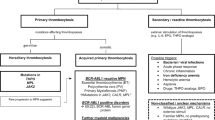Summary
From a population-based study on the incidence of potentially drug-associated blood dyscrasias 28 cases were identified with pancytopenia. Who recovered within 90 days after diagnosis. Early recovery occured more frequently in patients showing normal or increased cellularity of the bone marrow than in patients with bone marrow hypoplasia. Median recovery times of leukocytes were 14 and 10 days and of platelets 21 and 9 days in patients with and without bone marrow hypoplasia, respectively. Age and sex distribution were similar in both groups. Of 28 patients, 11 reported a period of fever before onset of pancytopenia. Sixteen patients in whom information on drug use was available had taken a median of 4 drugs before the onset of symptoms that were related to pancytopenia. From these results we present the hypothesis that transient pancytopenia with or without marrow hypoplasia can be the expression of the same type of bone marrow injury and that drugs or viral infections should be considered as etiological factors.
Similar content being viewed by others
References
Barzel US (1967) Quinidine-sulfate-induced hypoplastic anemia and agranulocytosis. JAMA 201: 325–327
Bernard J, Schaison G (1987) Transitory bone marrow failure. Am J Pediatr Hematol Oncol 2: 141–144
Clausen N (1986) A population study of severe aplastic anemia in children. Incidence, etiology and course. Acta Paediatr Scand 75: 58–63
Dhingra K, Michels SD, Winton EF, Gordon DS (1988) Transient bone marrow aplasia associated with non-A, non-B hepatitis. Am J Hematol 29: 168–171
Frickhofen N, Raghavachar A, Heit W, Heimpel H (1986) Human parvovirus as a cause of transient pancytopenia. N Engl J Med 314: 646
Gouffier E, Schnurmann D, Durepaire H, Vernant JB (1978) Transient marrow aplasia during cimetidine treatment [letter]. Nouv Presse Med 7: 2660–2660
Heimpel H (1979) Laboratory aspects of aplastic anemia. In: Geary CG (ed) Aplastic anemia. Balliere Tindall, London, pp 63–81
Heimpel H (1988) Drug-induced agranulocytosis. Med Toxicol 3: 449–462
Heit W, Heimpel H, Fischer A, Frickhofen N (1985) Druginduced agranulocytosis: Evidence for the commitment of bone marrow haematopoiesis. Scand J Haematol 35: 459–468
Idänpään Heikkilä J, Alhava E, Olkinuora M, Palva IP (1977) Agranulocytosis during treatment with clozapine. Eur J Clin Pharmacol 11: 193–198
Israeli A, Or R, Leitersdorf E (1985) Captopril — associated transient aplastic anemia. Acta Haematol (Basel) 73: 106–107
Kornberg A, Rachmilewitz EA (1982) Aplastic anemia after prolonged ingestion of indomethacin. Acta Haematol (Basel) 67: 136–138
Leen C, Gibb AP, Brettle RP, Welsby PD (1982) Transient neutropenia and thrombocytopenia due to benoxaprofen [letter]. Lancet I: 1302–1302
Lima J, Biosca M, Ribera A, Garcia Bragado F (1986) Immune neutropenia and thrombopenia in infectious mononucleosis [letter]. Med Clin (Barc) 86: 481–481
McLaren GD, Doukas MA, Muir WA (1978) Methypryloninduced bone marrow suppression in siblings. An inherited defect? JAMA 240: 1744–1745
Mir MA, Geary CG (1980) Aplastic anemia: an analysis of 174 patients. Postgrad Med J 56: 322–326
Moreb J, Shemesh O, Shilo S, Manor C, Hershko C (1983) Transient methimazole-induced bone marrow aplasia: in vitro evidence for a humoral mechanism of bone marrow suppression. Acta Haematol (Basel) 69: 127–131
Neftel KA, Hauser SP, Muller MR (1985) Inhibition of granulopoiesis in vivo and in vitro by beta-lactam antibiotics. J Infect Dis 152: 90–98
Neftel KA, Walti M, Spengler H, von Felten A, Weitzman SA, Burgi H, de Weck AL (1981) Neutropenia after penicillins: toxic or immune-mediated? Klin Wochenschr 59: 877–888
Picozzi VJ, Swanson GF, Morgan R, Hecht F, Greenberg PL (1986) 13-cis-retinoic acid treatment for myelodysplastic syndromes. J Clin Oncol 4: 589–595
Pisciotta AV (1973) Immune and toxic mechanisms in drug induced cytopenias. Semin Hematol 10: 279–310
Rothman IK, Amorosi EL (1979) Procainamide-induced agranulocytosis and thrombocytopenia. Arch Intern Med 139: 246–247
Ruvidic R, Jelic S (1972) Haematological aspects of drug-in-duced agranulocytosis. Scand J Haematol 9: 18–27
Schmid L, Heit W, Flury R (1984) Agranulocytosis associated with semisynthetic penicillins and cephalosporins. Report of 7 cases. Blut 48: 11–18
Seip M (1983) Aplastic anemia during ethosuximide medication. Treatment with bolus-methylprednisolone. Acta Paediatr Scand 72: 927–929
Strair RK, Mitch WE, Faller DV, Skorecki KL (1985) Reversible captopril-associated bone marrow aplasia [letter]. Can Med Assoc J 132: 320–322
The international agranulocytosis and aplastic anemia study (1983) The design of a study of the drug etiology of agranulocytosis and aplastic anemia. Eur J Clin Pharmacol 24: 833–836
The international agranulocytosis and aplastic anemia study (1986) Risks of agranulocytosis and aplastic anemia — a first report of their relation to drug use with special reference to analgesics. JAMA 256: 1749–1757
The international agranulocytosis and aplastic anemia study (1987) Incidence of aplastic anemia: The relevance of diagnostic criteria. Blood 70: 1718–1821
The international agranulocytosis and aplastic anemia study (1988) Risk of agranulocytosis and aplastic anemia in relation to antithyroid drug use. Br Med J [Clin Res] 297: 262–265
The international agranulocytosis and aplastic anemia study (1989) Anti-infective drug use in relation to the risk of agranulocytosis and aplastic anemia. A report from the International Agranulocytosis and Aplastic Anemia Study. Arch Intern Med 149: 1036–1040
Vincent PC (1986) Drug-induced aplastic anemia and agranulocytosis. Incidence and mechanisms. Drugs 31: 52–63
Wickramasinghe SN (1975) Human bone marrow. Blackwell, Oxford London Edinburgh Melbourne
Young GAR, Vincent PC (1980) Drug-induced agranulocytosis. Clin Haematol 9: 483–504
Author information
Authors and Affiliations
Rights and permissions
About this article
Cite this article
Keisu, M., Heit, W., Lambertenghi-Deliliers, G. et al. Transient pancytopenia. Blut 61, 240–244 (1990). https://doi.org/10.1007/BF01744138
Received:
Accepted:
Issue Date:
DOI: https://doi.org/10.1007/BF01744138




